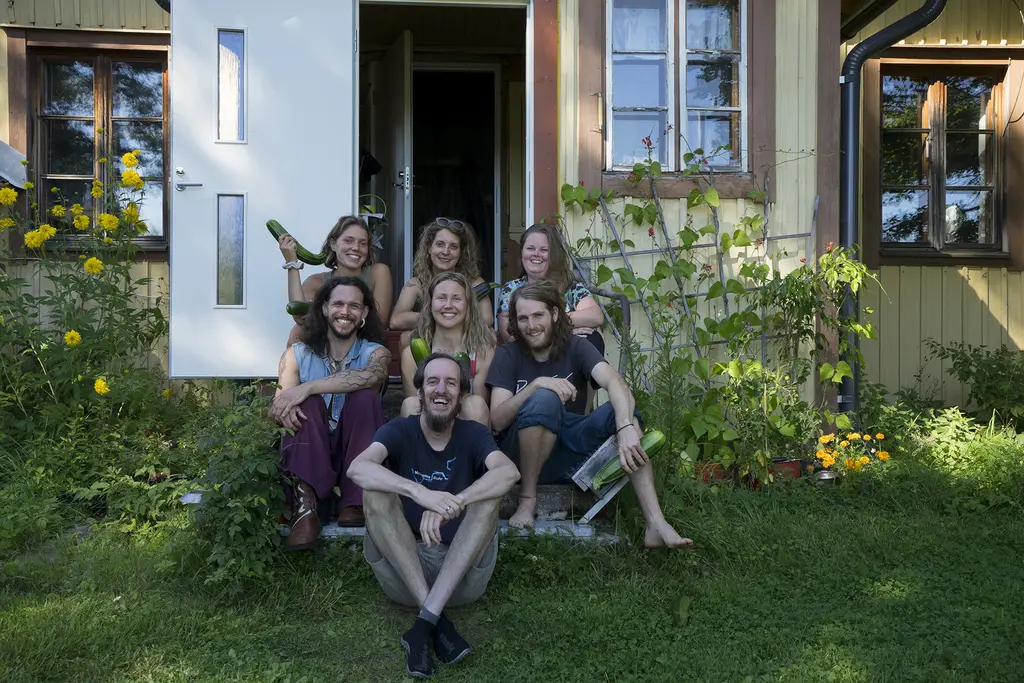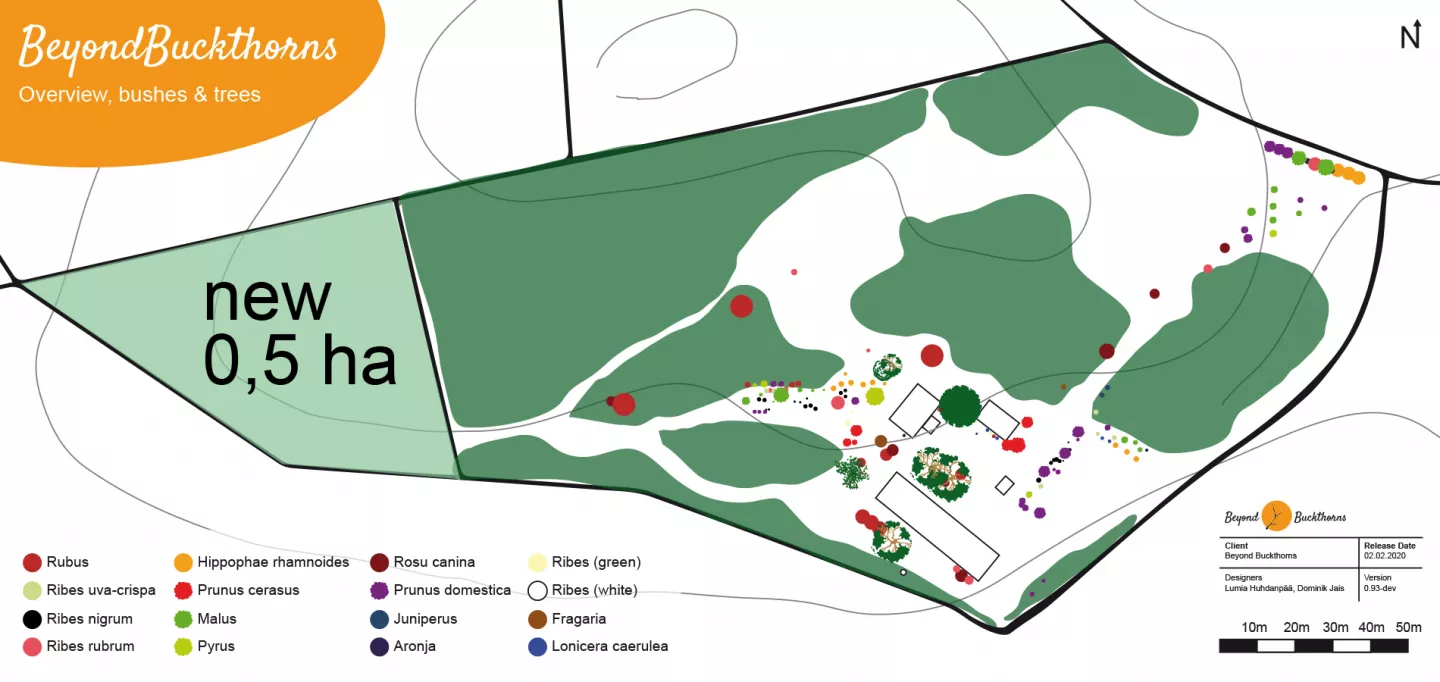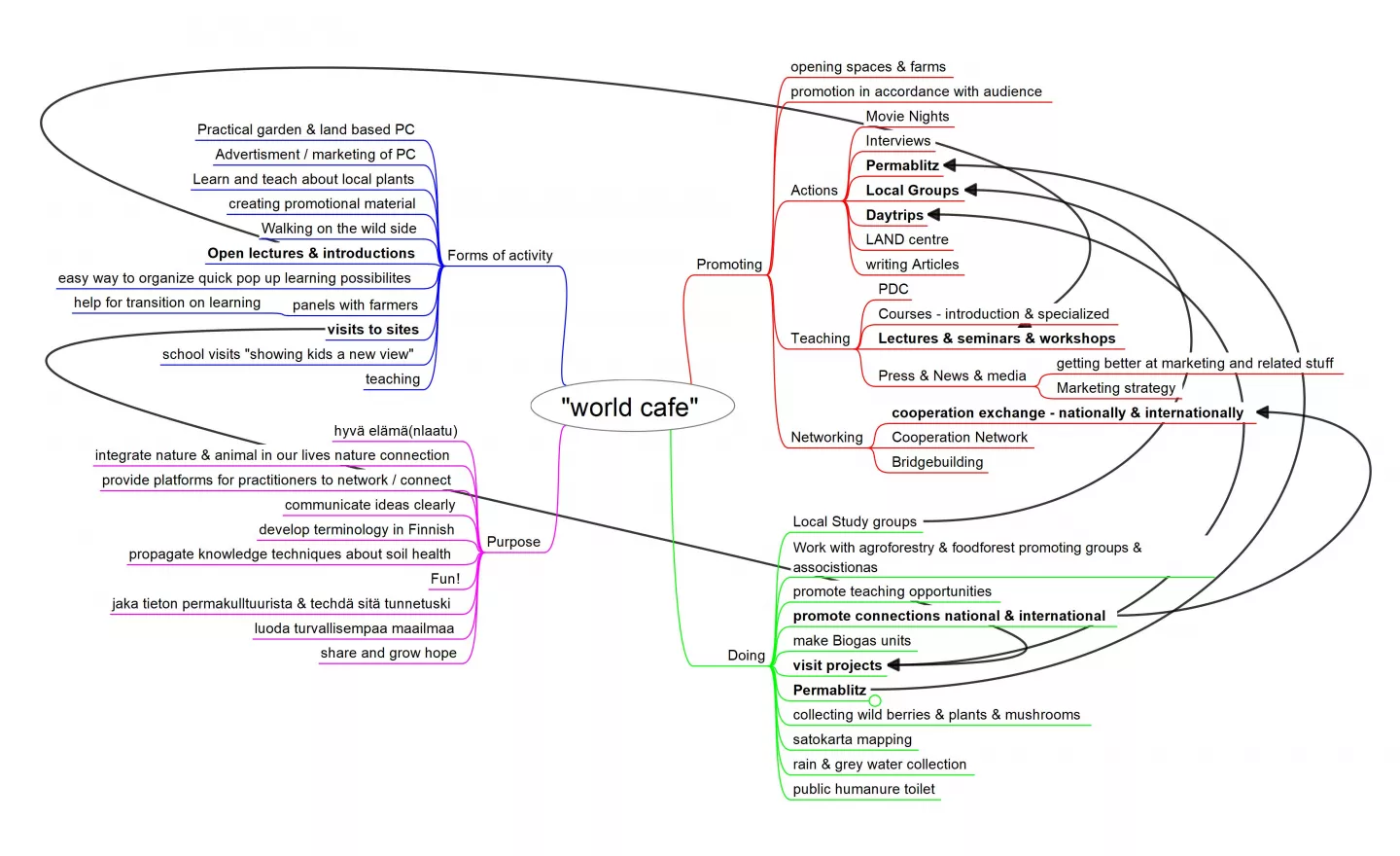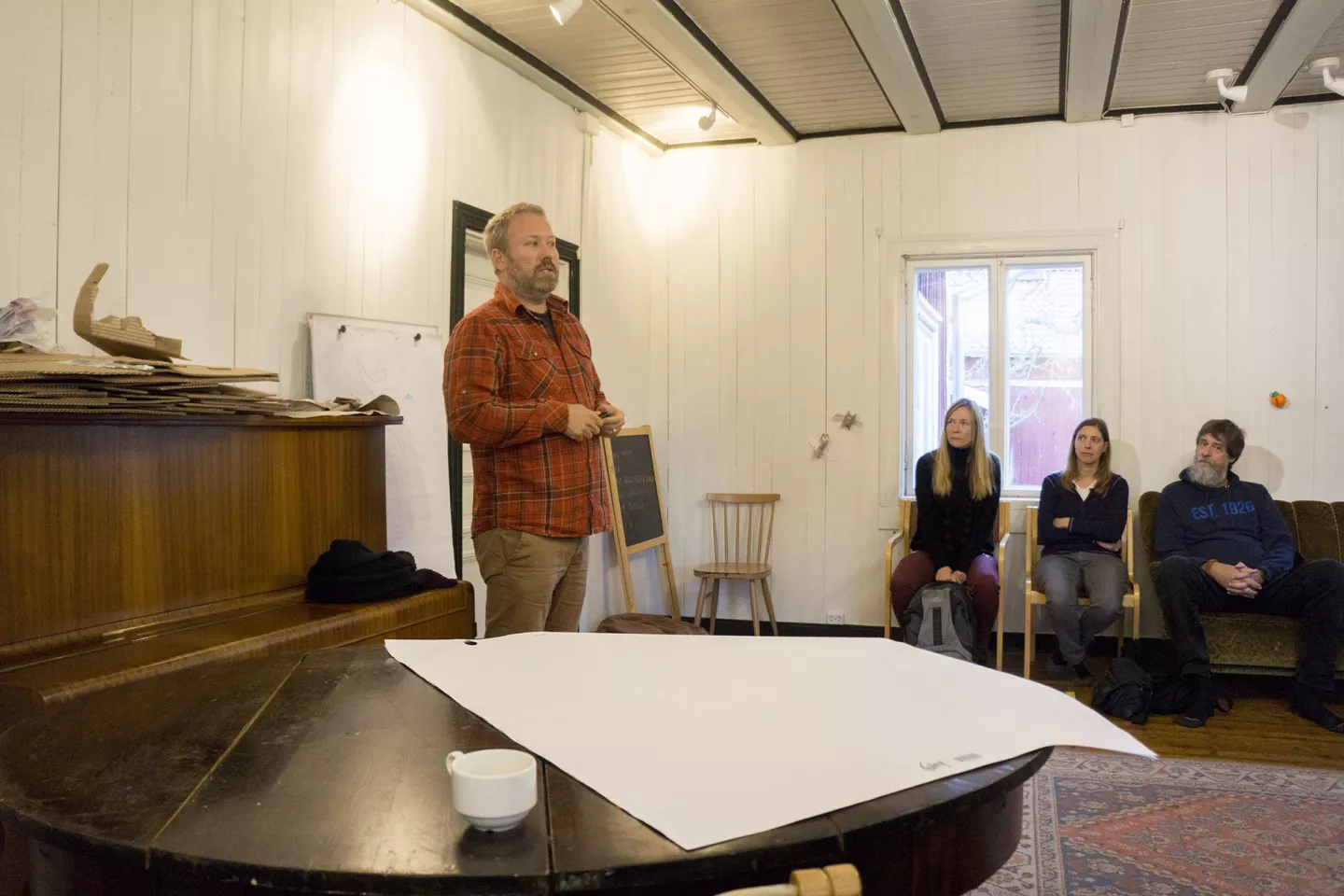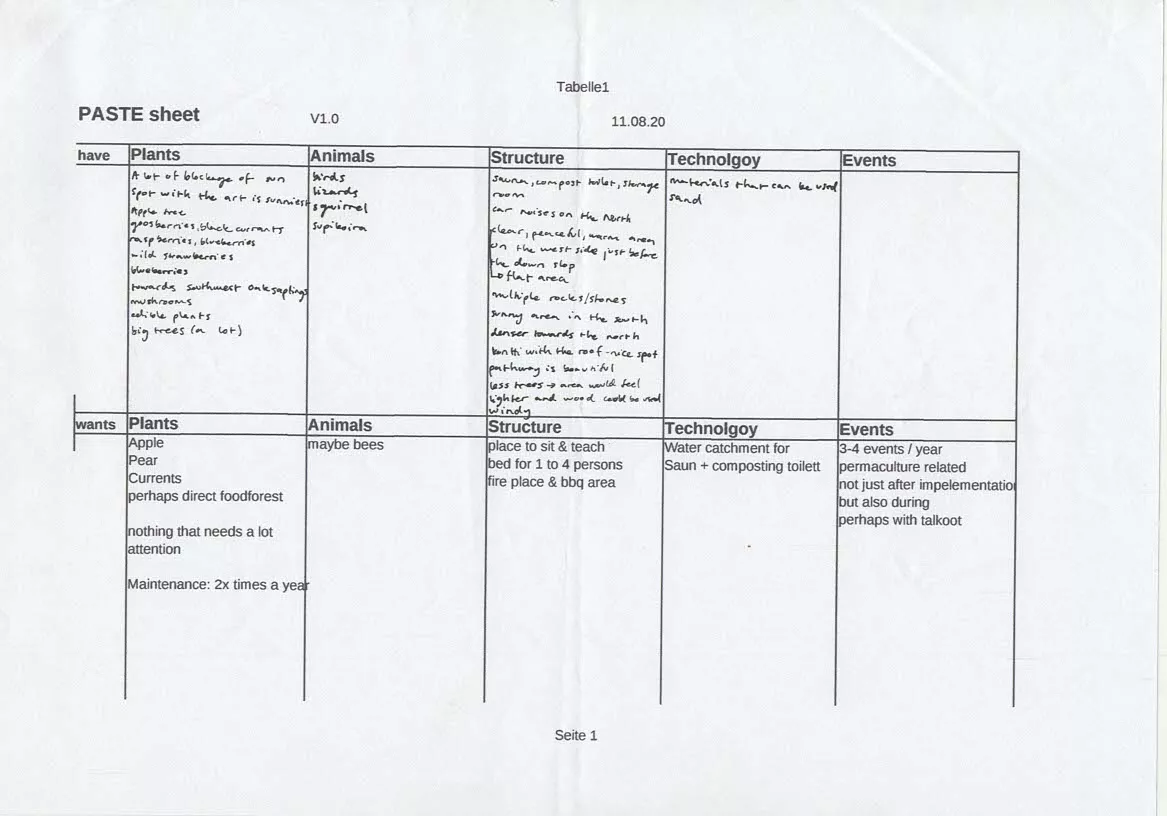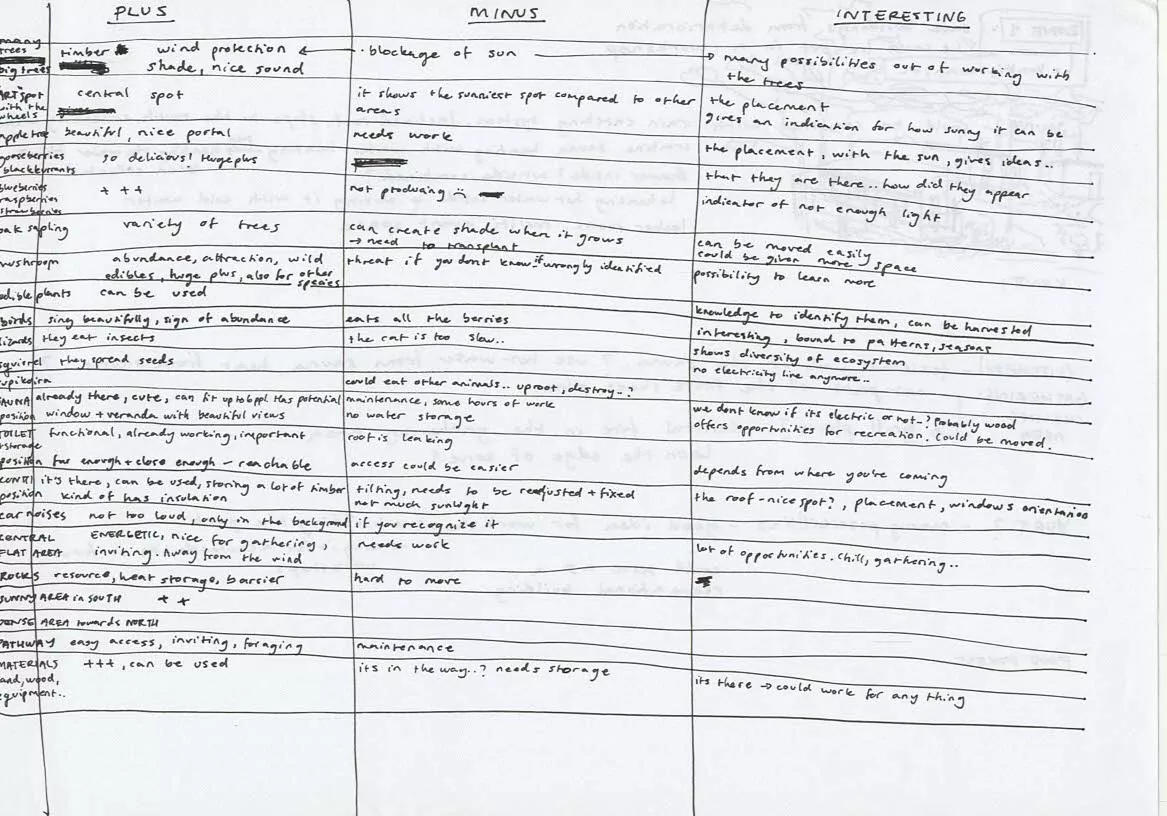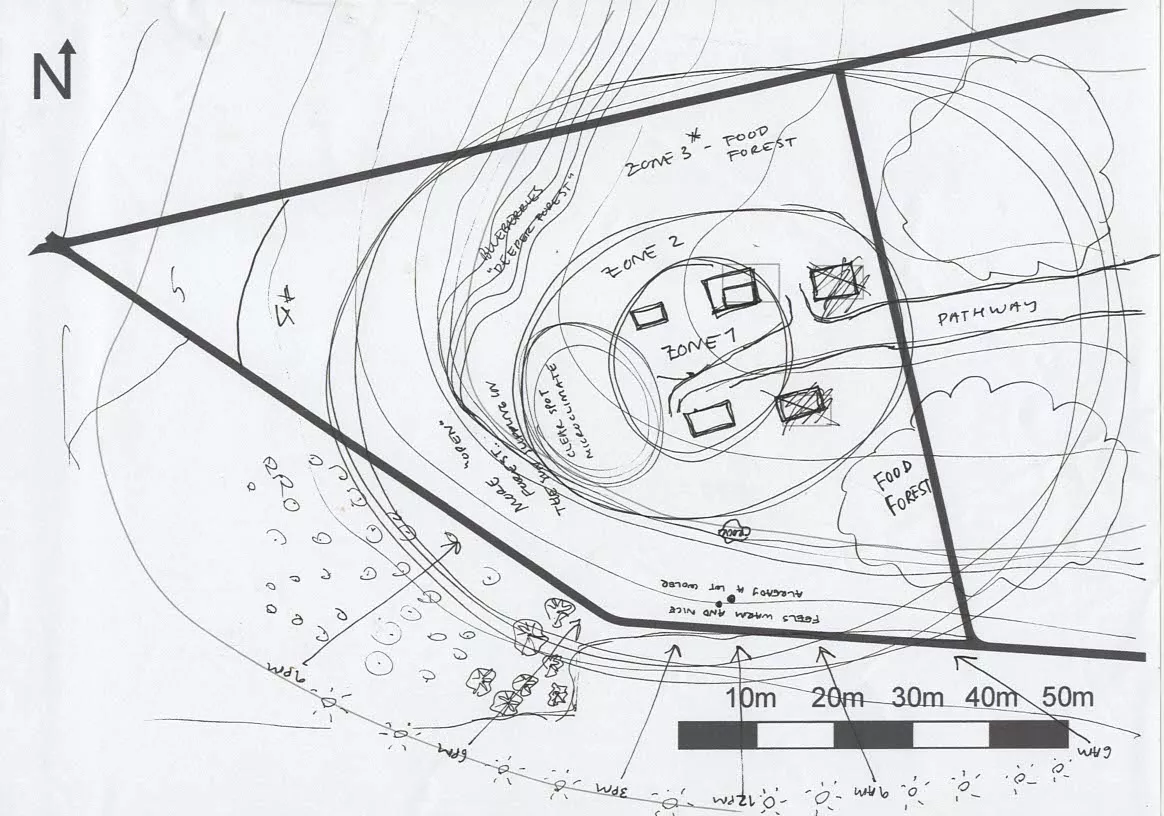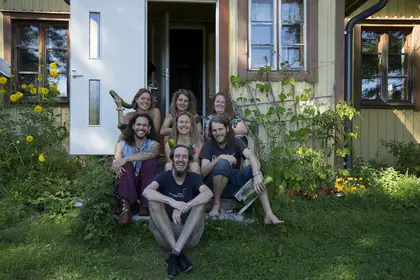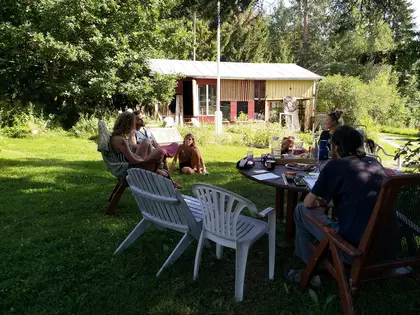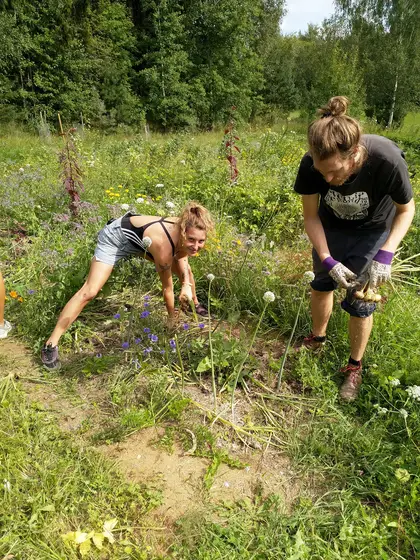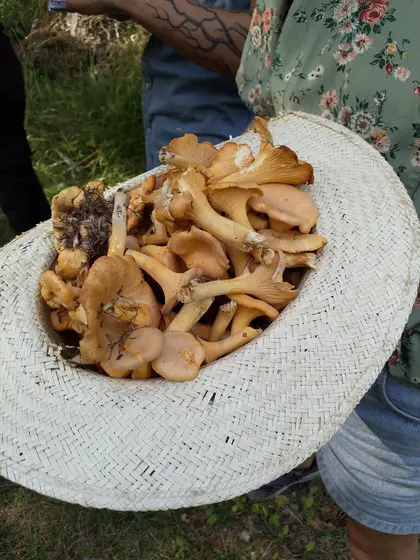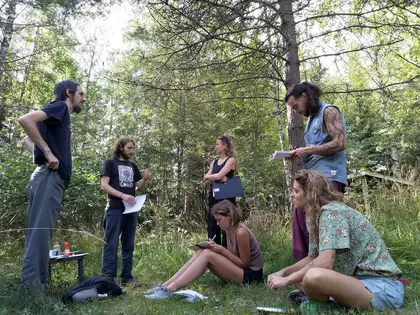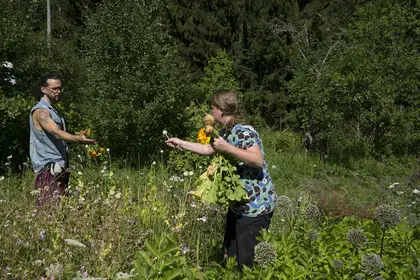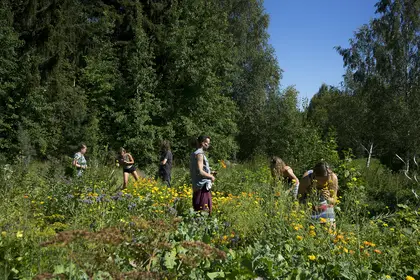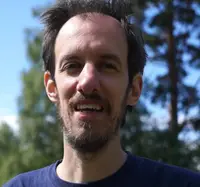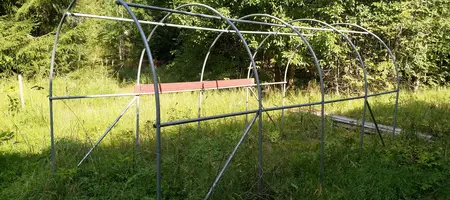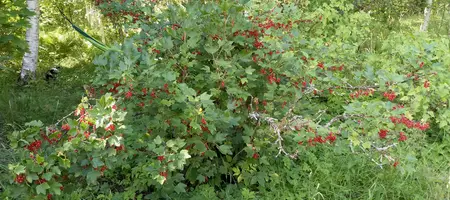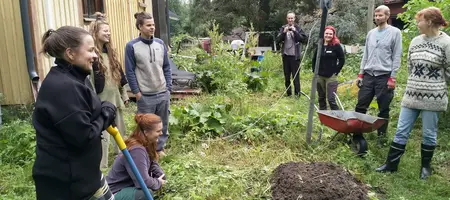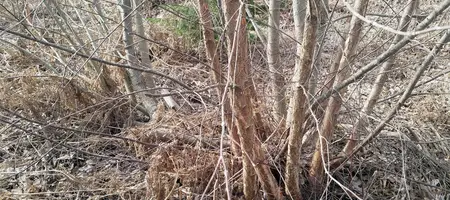Preface
In early 2020 we bought the neighbors 0,5ha pine forest / recreational spot that was years back sold to them by Lumia's, my wife’s parents. The neighbors wanted to sell and for us it was a good opportunity to buy. Lumia then started the process of acquisition and some time later we owned the place.
The pine forest came with a sauna, a container filled with building materials (mainly timber), a tool shed with tools and a dry toilet. Remind me that I need to bring some Marvel comics to the dry toilet soon.
If you look at the map you can see that the bought 0,5 ha are in the western corner. In order to get there one needs to pass through our place. Therefore it was important for us to acquire this land now and not let it be sold to anyone else.
Let's get into it or to put it with Captain America's words "Whatever it takes!"
Before we started the acquisition we went there for observation but we soon realized that there are a lot of things in our heads concerning our main living area and that those other projects have priority. We therefore put the new area on a back-burner. Time went by and an idea about having other people over to help us design the new area emerged. Perhaps this could be done as a workshop, course or a permabliz? During the spring and summer Lumia and I had familiarized ourselves with Looby's design web. Some of my previous designs used it and since OBREDIM, SADIM and CEAP are more for land based design and the outcome of this social design isn't clear, it might be the best choice.
Goals
The goals in accordance with the permaculture ethics as follows:
Earth Care: Direct: Make sure students do something practical in the garden during the course. Hands on! Indirect: Make sure students understand the necessity of Earth Care and are given ideas on how to do it in practice
People Care: teach and empower people; let them teach each other and learn by working together! Make all the participants feel welcome and that their input is of value for the project.
Fair Share: for me: getting all the input needed | from me: giving information about permaculture & permaculture design & produce from the garden
Looby's web process
Vision
Create a new type of permaculture course that unleashes the collective genius.
Helps
- previous knowledge from TPT (teaching permaculture teachers) & PDC (permaculture design course)
- Lumia's input
- community / people
- Cathrine’s teaching cards PDF
- Core curriculum PDF's (UK Permaculture Association)
- Introduction curriculum PDF's (UK Permaculture Association)
- personal TPT notes and documents in shared Google Drive (already downloaded)
Courses
I usually do a PMI (Plus / Minus / Interesting) but since the following is from my personal experience I use another tool I just made up. I call it BWC analysis. This is short for Best | Worst | Change. It is actually pretty simple. It is derived from the debrief practice during the TPT where a participant gets asked the following questions:
- What was best?
- What was worst?
- What would you change?
PDC |
|
|
Best | Worst | Change |
the last 2 days, the design phase | sometimes too compacted information | emphasis on designing |
the team building |
|
|
the discussions with the participants in between lectures |
|
|
the individuals |
|
|
TPT |
|
|
Best | Worst | Change |
the last 2 days, the design phase | too compacted | less compact |
the team building | too many hours per day in classroom | more time |
the discussions with the participants in between lectures | incorrect or outdated knowledge |
|
the individuals |
|
|
micro-teaching |
|
|
Community
The following mind map was created my after the 2019 Christmas get-together of the Finnish Permaculture association. Each of the main branches, “Forms of activity”, “Purpose”, “Promoting”, and “Doing” were topics on tables of a modified Worldcafé that the association run during that event. Modified in terms that we didn’t switch tables.
On that mindmap the term “Permablitz” shows up twice. That means different individuals came up with the same idea. And since it is in “Promoting” and “Doing” it seems like an option that allows multiple functions per element.
Professionals
IPEN’s (international permaculture educators network) Lachlan McKenzie and Steve Charter run some research some time ago. They asked permaculture teachers a lot of questions, for example about participants countries, languages taught, books and materials used, etc. I got access to their research some time ago and remembered it when designing this course. One of the questions in particular is about practicals, hands-on experience.
The table below resemblance the findings that is in one of the PDFs (that I can’t publish here). The question was: “How important are practicals within the courses you teach or organise and what percentage of your courses are practicals?”
| Type | Essential | Very Important | Important | A little important | Not important |
| Introductory | 35,71% | 21,43% | 14,29% | 21,43% | 7,14% |
| PDC | 43,75% | 31,25% | 15,63% | 6,25% | 3,31% |
| Advanced courses | 38,10% | 28,57% | 23,81% | 4,76% | 4,76% |
| PC in schools / colleges | 60% | 33,33% | 6,67% | 0 | 0 |
| University / professional | 33,33% | 26,67% | 26,67% | 13,33% | 0 |
| Other | 70% | 30% | 0 | 0 | 0 |
The table / results are pretty clear: from 26 persons asked most find practicals in a course essential or very important.
The last line of the table is called “Other”. “Other” was the possibility to described additional course types. There were entries such as “Gateway to permaculture courses”, “observation, mapping, forest gardening, pruning, etc”, “Masterclass specialist courses”, etc. In total about 16 entries. Since the course I’m planning is of the type “Specialized course” I conclude that “Other” is the important row and practical hands-on is considered to be “Essential” or at least “Very important”.
The collective genius
Dan McTiernan from Wildfarm Permaculture, Finland, held a session during the Permaculture Association’s autumn meeting in 2018, which took place in Koroinen / Turku. He called his session “collective genius”. He basically leveraged the knowledge of all the participants in the room to solve problems people brought to the table. For example Lumia and I had some difficulties with the pathways on the estate and therefore brought a map and described the problem. The people in the room could then ask questions or come up with ideas. I found his session very helpful and hope that he runs it again!
A more common term for this topic is Crowdsourcing.
Limits
if we run a course at Beyond Buckthorns there are some limits:
- In August 2020 no sleeping space (ok, one) for guests -> therefore only tents or campers / RV
- number of people that can be hosted simultaneously with current infrastructure: ~ 8 to 12
- money: a little
- time: 3-4 weeks of preparation
Patterns
Not useful:
- I don't like to have people at Beyond Buckthorns at its current state (recurring)
- I usually dive to deep into topics – putting a lot of burden on the students (recurring)
Useful:
- I don't have any expectations. What happens happens, who is there is there (recurring)
- Finnish Summer is precious and short but the “dark summer” is a valid choice
Principles
Lumia and I will teach. We both go along pretty well and Lumia can hold me back if I'm diving to deep or change course. Two teachers mean multiple elements for important functions.
We use produce from the garden or cooking with the solar cooker or on biogas, we use biological resources. All food scraps go back to the biogas digester, all poo to the compost toilet. The course is set to produce no waste. Since the number of students participating will be small due to a limit set by the premises the group could be called a small-scale intensive system, a think tank, since a lot of exchange will happen, friendships are going to be formed and an awesome design will be crafted. A policy that I always hold up is: who comes, comes. It is about valuing diversity, the diversity of people. It is important to host it as an open event, not just something some small group will know about. Looby describes the Zones on a human level in her book. From Zone 0, me, to Zone 5, strangers I never met. The course is for everyone.
Ideas
In order to create a new course out of thin air serendipity is as usual my friend. From the Permaculture Association's mind map there is clearly the idea or need for a Permablitz. In Finland a Permablitz is called Talkoot (communal work). The idea is the same.
From the analysis of the different courses I find the last days of the TPT & the PDC the most interesting one: Designing at the PDC and designing a PDC at the TPT. From both courses I didn't like the compactness of information given.
Both courses put introverts into very difficult spots because bonds between people are formed at a lower pace. In my opinion the courses must be lighter, more digestible and with more possibilities to discuss topics between individuals / groups. And actually it should be fun doing something while learning something.
Implementation
Let's focus on the last 2 days of the TPT and PDC: The design phase. The design phase needs a goal, something that needs to be designed. As mentioned before in the preface we have bought some land. What would be a better candidate than a piece of land we have no clue what to do with it – or perhaps a clue, a vision, but that's it. Instead of Lumia and me designing something for others, we turn the tables and let others design for us. Unleash the collective genius while guiding the participants through a design process. Since Cathrine send me her design cards in order for me to learn different tools I immediately thought of them as something useful for the course (see helps). Her cards are based on the GoSADIMET design process, and therefore this is the process we are going to use. Because people need to camp we already have a name. We'll call it "Permablitz designCamp". designCamp alone would do I guess, but it should also be clear that work needs to be done. Important to note is that the course should be for free since it is the first time such a course is run (and developed) in Finland, a test run so to say.
Action
The list of actions that need to happen:
- Course pre-preparation
- choose a date -> possible 2nd year anniversary of our PDC + Perseid meteor shower
- create a schedule for the day and check it with Lumia
- create a lecture plan for the day
- hand decisions about food over to Lumia (she knows what is ready in the garden and she is the cook)
- prepare the Talkoot within Talkoot task list (I explain later)
- sector analysis based on the overall estate sectors
- Advertisement
- first course draft by me
- overhauled version by Lumia
- publication at website, social media and permaculture related channels
- Tools used during the course
- Print blank client interview
- PASTE sheet filled in the "wants"
- Draft the Go (Goals / Vision) of the GoSADIMET process together with Lumia
- Print the principles list, all of them, not just Holmgren's
- Print Cathrine's design tool cards
- Print the soil triangle
- Get a soil analysis on the way 5 to 7 days before the course
- Create a base map of the part the participants going to design for and print it in different scales
- Print the base map of the entire estate so that participants have an overview
- During the course
- Cooking with solar cooker
- Talkoot within Talkoot – help in the garden and with some heavy lifting
- Explain biogas when possible
- After the course
- Sauna
- BBQ
- Music
- Perseid binge-watching
Momentum
As always only some people signed up for the course. It is sometimes really frustrating and I don't know what I'm doing wrong. According to the findings of the association the people want "hands-on-permaculture experiences" like for example talkoots. They want more events and courses to happen. Either the information the Finnish Permaculture Association is basing their decisions on is totally false or there is something going on that I can't grasp. Permaculture is more than some herb spirals, keyhole gardens and raised beds. It is a holistic design philosophy that can be used to design anything. If it is enclosed and taken hostage by just and only gardening it can't fulfill its full potential. The universality of it makes it unique. Designing with permaculture is fun. Or as Steve Rogers put it: "I can do this all day long", so I can't really get frustrated by sign-up rates.
Action
The workshop went like this:
- Introductions & getting to know each other
- Introduction to the GoSADIMET process
- Go = Goals / Vision
- S = Survey
- Base map
- Soil analysis with calculation at the soil triangle
- PASTE sheet with wants filled in
- Client interview -> the participants asked Lumia and me
- visit to the site – giving everyone 20 – 30 minutes to walk around and take notes
- we found a large plot of Kanttarelil!
- filling in observation into the PASTE sheet
- Talkoot within Talkoot
- harvesting the onions in the annual garden
- mulching of the garden beds
- carrying of stones in order to clean out IBCs for another workshop
- Lunch from the garden & sharing what everyone brought to eat
- Continue GoSADIMET process
- A = Analysis PMI of the observations
- D = Design
- from pattern to details
- zones from 0 to 5
- multiple elements for important functions
- different events that combine teaching with infrastructure building
- multiple sleeping facilities / options
- rain water collection besides municipal water
- multiple functions per elements
- sleeping space is multi functional -> can be used for teaching
- other sleeping space can be used also for teaching
- sauna is also kitchen & laundry facility
- different trees can be used for different outcomes
- fungi growing on logs, cut or living tree
- timber
- fire wood
- use biological resources
- trees
- a lot of berry bushes
- mushrooms
- rain water instead of municipal water
- small scale intensive system
- integrate a food forest
- Naschpfad (German, path on which plants, bushes, trees are planted for consumption) towards the place (inspired by Tamera's lake walk from guest facility to the solar test-field)
- relative location
- the teaching area in harmony with the sauna, sleeping area, summer kitchen and dry toilets
- cycling of energy, nutrients, resources
- the dry toilet needs some upgrades
- diversity
- food forest
- edge effect
- value the area between the fields and the forest and the cut forest and the old forest
- from pattern to details
The map above shows the zones and placement of of some of the elements. (Thanks Anna)
- Relaxing evening & a good nights sleep in between
- Client presentation and debrief about the course after breakfast the next day
- How did we achieve Earth care?
- How did we achieve People care?
- And how did we achieve a Fair share?
Reflection
As already mentioned in the PermaCafé it usually takes people with enough courage to try something new. It is in my nature to innovate in whatever I'm doing. I can't really stand still and for example teach an introductory course over and over again. Even if I could change it within its boundaries the boundaries would be too heavy of a burden. It would be the same as with a PDC. If I would teach a PDC I would do it deferentially totally differently. Of course there is the core curriculum but there are nearly endless amounts of options that allows me to feel free enough while the introductory course with its two days would limit me too much. That's why I probably will never teach it.
The process, Looby’s work, is working for me, because it is flexible but still gives some scaffolding. All the different analysis helped to determine what type of course it should be and what I liked most about Permaculture courses.
From Lumia:
What was best?
- The people and their willingness to jump into learning and doing new things
- the new ideas and energy they brought to our place → no need to travel the world yourself, just have inspiring people over!
- Working together with Dominik on a permaculture project as equals
What was worst?
- All of the practical work was on me. I didn’t feel supported in this work→ give participants more responsibility & set clearer expectations, especially on a free course → fair share
- too much complex theory, too little time designing
What would you change?
- Set clearer expectations on participating with the practicals (food, sauna, cleaning up…) and give participants time to do this also
- have more hands-on work as pauses and time the day better
- set clearer limits to what is taught before designing – give the people only the tools they can use right now (and inspire them to get more information) but not overwhelm them
From me:
What was best?
- the participants designing
- learning while teaching
- being innovative
- the group
- the music – thank you Maxi and Iina!
- everyone!
What was worst?
- number of people interested in the course
- not enough time to proper step through the cards
- too much time for the process explanation
- not enough time for designing
What would you change?
- More time for designing
There is also of course feedback from the participants, which I don't discus here, since it will help me to tweak the course further. What I realize is that it needs that further tweaking to become something that I can run more often, perhaps once a year. The emphasis needs much more on the doing side. I think that such a specialty course is needed. It gives inside into how a designer does their work. If tweaked it could be one of the most beneficial courses available.
| Strength | Weakness |
| transfer of knowledge | topic might be difficult |
| practical hands on | needs a lot of knowledge |
| price point | peoples ability to dive in |
| Opportunity | Challenges |
| flexibility | the journey of the design – take everyone onto the journey |
| team building capability | what to design |
Appreciation
It is not always about what I want. When Maria was saying that growing food in the city is a luxury I remembered a sentence that Ethan Hirsch-Tauber once used during a video call and so I corrected her by quoting Joseph Cooper from Christopher Nolan's movie Interstellar: "It is necessary". I highly appreciated the input from all the participants, Alexis who I admire for his knowledge of wild plants, Maxi for his guitar and flute play, Maria for her charming character and ideas, Iina for her ideas and singing, Anna for finding the Kanttarelli and her drawings and of course Lumia for being just there (and the marvellous cake and food she prepared). And while I didn't expect anything to happen I saw the biggest meteor I have seen since I was in Portugal in August 2015. Red glowing, like the sky was burning. At that moment I thought of how wonderful the people and the place is.
Accreditation criteria
Demonstrating design skills
- Looby’s Web
- Ethics
- Principles
- Looby’s People Zones
- PMI amended to BWC
- SWOC
- Mindmap
- Helps & Limits (part of Looby’s web)
- Research analysis
Applying permaculture in my own life
Bringing people into my life that I don’t know or people that I know a little and then friends and family is like the entire zone of people is present. Kind of fun fact is that with each design I regain more of my lost creativity. It was buried under tons of negative sentences from curators like Dr. Schramm telling me how unwanted I am and how I’m not part of the artist community. Denying me access to ateliers while his friends claimed that they just had to call "Uwe" and get what they want.
Learning from and developing your permaculture practice
I think that some of the design tools still taught are outdated. And I think there must be enough room for ones own design tools. If we limit the usage to only the tools we know then we are stuck.
For me it is never about the size of the design and how many words I need to write that defines the “size” of the design. It is about the innovative force and its ingenuity. There can’t be any standing still in permaculture using the same old tools over and over again. I need to see if BWC will work for me in further designs. But for this is does.
Cathrine’s tool cards were very helpful. I hopefully can use more of her suggestions in the next design.
I now have empty digitally stored documents (blueprints) for
- PASTE Sheet
- Client Interview
- PMI / SWOC
that I can use in future designs and courses.
Applying permaculture to my work and projects
Within Holmgrem’s domain this design is of course “Education and Culture” and on the edge of “Health and spiritual well being”. “Education” because it is clearly a course that teaches an important part of permaculture, the design process, but also “Spiritual well being” because it brings the personal zones in place and let’s me experience the friendship that I sometimes miss on the country side. Actually workshops are far more important on the social side than on the monetary side.

